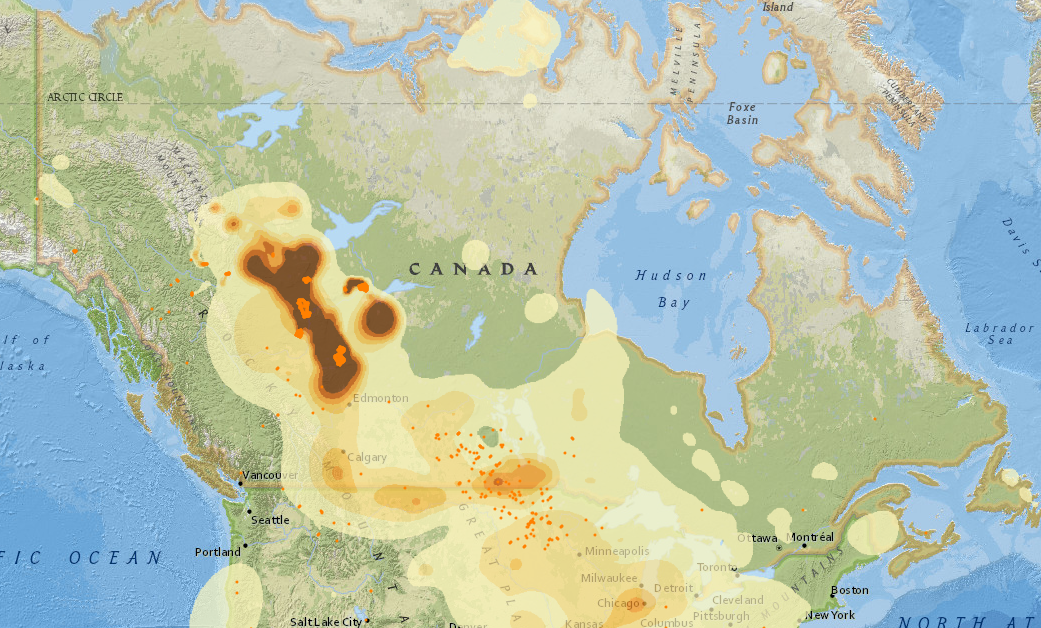Wildfire season has sparked to life in Alberta, destroying homes, putting others at risk and forcing evacuation orders throughout the province’s north.

The effects of the wildfire won’t just be felt in the province, however. Modelling projects that smoke from the wildfires could drift all over Canada in the coming days, reaching as far east as Newfoundland and as far south as Kansas.
WATCH: Aerial footage of northwest Alberta wildfires shows large smoke clouds over province

With smoky conditions come health warnings that advise people to check air quality, stay inside and clean the air in their homes.
But what exactly happens when people breathe in smoke? How does it upset the lungs, the heart and the body overall?
LISTEN BELOW: What happens to our body when we inhale wildfire smoke
In Canada, air quality and smoke concentration is often calculated by measuring PM2.5, or particulate matter measuring 2.5 micrometres in diameter or less.
Such measurements allow for smoke forecasts like the one displayed below — the darker areas represent higher PM2.5 concentrations:
PM2.5 can be made up of any matter; it depends entirely on where the emissions come from.
Where wildfires are concerned, particulate matter is often made up of soot from burning trees.
The soot can become little “spitballs” that stick together to make bigger particles, explained Sarah Henderson, senior scientist in environmental health services at the BC Centre for Disease Control (BC CDC).
READ MORE: Vancouver’s smoky haze is dragging down the scenery, and you. Here’s how
“Mostly they’re going to be made of carbon in various forms, but there can be other stuff in there as well,” she told Global News.
“Anything that was in the source material that was burning, in this case the trees, can wind up in the particles, so there will be trace amounts of heavy metals.
“But mostly what’s happened is the organic matter, the hydrocarbon has been combusted down to just the carbon.”
WATCH: Sept. 7, 2017 — Smoky air from wildfires getting you down?

Health risks can arise when people breathe in these particles, provoking an immunological response in the body, Henderson said.
“These particles can’t be filtered out by your nose or mucus because they’re too small,” she said.
“So they pass right through those systems and they go straight into the lungs. And the smaller they are, the more deeply they can penetrate.”
The body treats these particles like “foreign invaders,” provoking an immunological response, and defending itself in a way it might against a virus or bacteria.
PM2.5, however, can’t be killed like viruses can, so the body remains in a state of systemic inflammation, Henderson explained.
The body experiences inflammation in response to bacteria and other phenomena, causing swelling by having blood vessels leak fluid into certain tissues, according to the U.S. National Library of Medicine.
READ MORE: Alberta wildfires — evacuation alerts and orders in place across the province
The inflammation can mean harm to several parts of your body when you breathe in smoke.
Exercise, Henderson said, can increase the intake of smoke because you’re breathing in 10 times more air than you would be at rest.
“So you’re more exposed to whatever’s out there,” she said.
Health warnings linked to wildfires largely focus on areas such as the respiratory system and the heart.
Lungs
Medical study has determined a close link between wildfire smoke and asthma.
Studies have shown more visits to the doctor, as well as the emergency room, and hospitalization for asthma linked to wildfire smoke exposure, according to a 2016 literature review led out of the Harvard Center for Population and Development Studies.
Some studies have found “no significant acute changes in lung function among people with asthma” related to particulate matter.
WATCH: Good Samaritans help rescue livestock out of path of Alberta wildfires

They did, however, find “significant declines in lung function” among those who did not have asthma.
That discrepancy might be explained by “increased use of rescue medication in response of elevated levels of smoke,” said the review.
There’s also increasing evidence for a link between wildfire smoke and chronic obstructive pulmonary disease (COPD), a name for a group of lung conditions that can include emphysema and chronic bronchitis, as explained by the Lung Association.
READ MORE: B.C.’s wildfire smoke isn’t just floating across Canada — it’s reaching Ireland
Research has found increasing hospitalization rates and doctor visits linked to wildlife smoke exposure; there’s also evidence of “increased reliever medication dispensing” during wildfire smoke events in British Columbia.
Studies have also drawn a connection between wildfire smoke and pneumonia, as well as acute bronchitis. Research from 2011 showed increased visits to emergency departments following exposure to smoke from a peat fire in rural North Carolina.
Heart
Health warnings about wildfire smoke often mention risks to people with heart disease, with older individuals more likely to be affected.
Cardiovascular research around wildfire smoke, however, has not necessarily produced consistent results, the review said.
Australian research has drawn a link between out-of hospital cardiac arrests and PM2.5; it has also found a link to hospitalizations for acute myocardial infarctions (MI), a condition that results from the obstruction of a coronary artery, which supplies the heart with blood.
WATCH: Evacuation orders expand as northern Alberta wildfires grow

Other studies, however, have not found links between wildfire smoke and cardiac failure within emergency departments.
Nor have certain researchers established a connection between wildfire smoke and cardiac failure in emergency visits.
“Too few studies and too many inconsistencies in findings exist to determine whether wildfire smoke exposure is associated with specific cardiovascular outcomes,” the review said.
Mental health
The link between wildfires and mental health hasn’t always been drawn very clearly in medical research.
Evidence of psychological impairment exists, but smoke exposure hasn’t necessarily been identified as the cause.
In the summer of 2017, Vancouver residents found themselves living with a smoky haze due to wildfires burning in B.C.’s Interior, and in the state of Washington.
WATCH: Sept. 6, 2017 — Smoke from B.C. wildfires obscures the sun in Vancouver

At that time, Chris Carlsten, a respirologist with Vancouver General Hospital (VGH), told Global News that evidence is mounting to suggest that some PM2.5 particles are small enough to enter the brain and cause “neuro-inflammation.”
Such inflammation can affect people’s moods and their cognitive abilities, he said.
There could also be effects on mental health because of smoke’s obscuring effects, Carlsten suggested.
READ MORE: Smoke from the Alberta wildfires is obscuring the sun in several U.S. cities
“Green and blue, for example, are positive colours that are associated across a range of positive health effects,” he said.
“Not being able to see those could decrease our mood, make us feel worse.”
Within medical literature, many studies have found evidence of psychological effects from wildfire.
WATCH: Manning put on evacuation alert because of wildfire threat

A 2011 study out of Greece, for example, showed that people who had suffered loss from a wildfire scored “significantly higher in the symptoms of somatization, depression, anxiety, hostility, phobic anxiety, paranoia, and had significantly more symptoms and were more distressed” next to controls.
That study, however, did not specifically look at smoke — and the research that’s been done hasn’t exactly been definitive.
The literature review found six studies that looked into the link between wildfire smoke exposure and mental health effects. Four of those studies had “higher potential for bias” and two others saw “no increase in physician visits for mental illness” that were associated with PM2.5 during B.C.’s wildfire season in 2003.
What do you do?
With wildfire season raging, those affected by smoke can take several steps to protect themselves.
They can regularly check air quality reports, exercise indoors, and keep the air in their homes clean by running an air conditioner — so long as you close the fresh-air intake and clean the filter to keep smoke from penetrating where you live, according to the Centers for Disease Control (CDC).
They can also hope for rain — that can take smoke right out of the atmosphere.
“The thing that removes smoke most quickly is a good rainfall,” Henderson said.
— With files from Linda Aylesworth






Comments